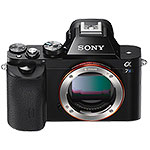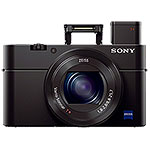Nikon P300

- sleek, retro styling
- slightly larger body
- 1/2.3" 12MP sensor
- 6.6oz w/battery
Nikon's 12-megapixel P300 is marketed as a high-end and higher-quality compact digital camera—possibly even high enough to replace a much larger DSLR.
I've learned to carry compacts in addition to or even instead of DSLR's when I'm climbing and skiing. Anything you can put in your pocket is (1) much easier to access and therefore (2) much more likely to be used. The P300 would thus seem to be a perfect choice for those photographers seeking DSLR-level image quality in a sleek, lightweight package.
These sorts of "prosumer" compacts are starting to appear in all the manufacturer's lineups—for good reason. Photographers both amateur and pro are coming to realize that today's technology allows mirrorless cameras to rival DSLR quality at a fraction of the size and weight. Immediate competitors to the P300 would include Canon's Powershot S95 and Panasonic's Lumix GF2—both of which are highly-regarded cameras. Note that both these cameras offer larger 1/1.7" sensors, in comparison to the P300's smaller 1/2.3" sensor—a key difference.
Larger sensors mean physically bigger pixels, which can translate into dramatically better low light performance. Indeed, the drive to include bigger sensors in smaller cameras is in part what led to the radical design of Sony's NEX-5 compact, which uses a DSLR sensor in a compact body! Another key difference between the P300 and its peers is lack of RAW support. The P300 records jpegs only, limiting post-processing options. So, now that we've gotten the preamble out of the way, how does the P300 actually perform?
My workhorse compact is an old Canon SD940IS. I am sorry to report that in nearly every way, I prefer the image quality of my SD940 to the much-newer Nikon P300. That's curious, because the SD940 has exactly the same sensor size: 1/2.3" and 12 megapixels. Both cameras are fairly aggressive in processing their jpegs, including both sharpening and contrast enhancement, but side-by-side, the Canon's look far more natural, with an aesthetically-pleasing sharpness, and punchy but not overdone contrast.
To my eye the P300 images look over-sharpened—something unpleasant is happening with regard to "grain" and edges. And contrast/color is often way over the top, over-saturated unpredictably. The P300 is at its best in bright sunlight. In lower light, image quality drops precipitously.
I confess the primary reason I bought my P300 was for its advances in video functionality (and presumably) video quality. The P300 shoots 1920x1080 HD video at 30 progressive frames per second (NTSC), using .H264 compression at 17Mbps (I believe) in a .mov wrapper. The P300 also includes image stabilization—a critical feature for video. Most impressively, the P300 offers continuous autofocusing and zooming while shooting—something neither the Canon S95 nor the Lumix GF2 can do. How was the P300's actual performance? I am even more sorry to report that the P300's video quality was disappointing. Once again, my trusty old-ancient SD940IS kicked the P300's butt.
It's been understood for some time that Nikon lags Canon when it comes to video technology, at times by some 1-2 years, but recently Nikon has shown a lot of commitment to improving video in its cameras (ie, the D7000). That said, continuous autofocusing and zooming proved to be far less effective than I'd hoped. Those features do work...just not very well. Take a look at my Girly Man Chute video, shot with the P300, and you'll see all the P300's warts in action.
Autofocus works, but it's almost constantly hunting, moving in and out...continuously. When I zoom, the camera temporarily loses focus, and zoom noise is evident on the audio. Or I should say, zoom noise would be evident if not for the atrocious wind noise, made worse by the P300's expanded audio range, which captures low rumble in all its offensive glory. There is no way to use an external microphone. Image stabilization is generally good, reducing hand shake, but any quick movement leads to dramatic shutter roll artifacts.
Finally, video quality is hardly inspiring: edges show wild aliasing artifacts, dynamic range looks pinched, highlights are crushed, sharpness is poor. Subjectively and objectively, the performance is poor. What does the 720-30p video from my old Canon SD940 look like in comparison? Check out my Baldy North Face video. It's not even close, is it?
I love the way the Nikon P300 looks. Its styling is retro, recalling those old famous Leica cameras. That's about all I like about it. Image quality is probably average for a compact with a sensor this size. Video quality is poor, despite the massive full HD-resolution. The introduction of raw recording, possibly as a firmware update, would likely offer a big improvement to still image quality, albeit at the cost of significant post-processing work. I don't foresee any significant improvement in video quality. The P300's best argument is its price: at $325/market, it is less expensive than the elite compacts it would seem to be competing with. But, as they say, you get what you pay for...
 Sony A7S
Sony A7S Sony RX100 M3
Sony RX100 M3